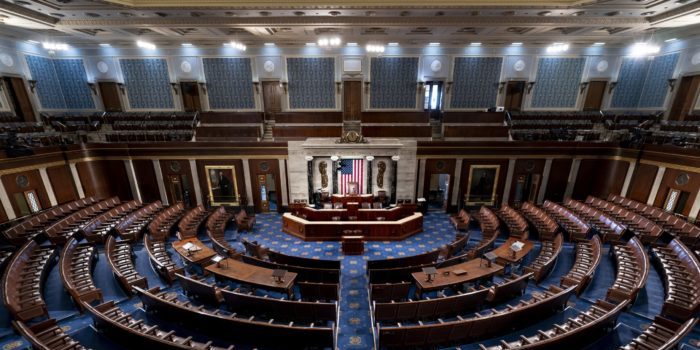(Headline USA) If Republicans have a resounding midterm rout in the 2022 midterm election, it won’t be a popular mandate against the Biden administration’s policy failures, which have inflicted unprecedented pain and government overreach on the daily lives of Americans.
Rather—like the shellacking that former President Barack Obama received in 2010—it’s all about the maps, stupid. Or so claim mentally deranged leftists like those running the Associated Press.
Notoriously biased AP reporter Nicholas Riccardi once again vomited partisan talking points onto a page in his disgraceful analysis of GOP efforts to fight the shocking attempted power-grab being led by Obama and his former wing-man, ex-Attorney General Eric Holder, through the National Democratic Redistricting Committee.
He used a bogus claim that the maps were systemically racist, or something—citing the fact that Democrats always prevail in the “popular” vote without acknowledging that the polling itself is rigged by people like the AP to falsely frame the political outcome and suppress opposition.
Moreover, states like California that lack election-integrity laws have regularly used ballot-harvesting to pad the outcome of the “popular” election with illicit and ineligible votes, knowing that they will not face the same scrutiny as states still subject to the rule of law.
In the 2018 midterm election, Democrat activists succeeded in deploying their “sue till blue” strategy, empowering activist judges to force red-state legislatures to redraw their 2010 maps while granting a free pass to the overtly partisan blue-state maps in places like New York.
In 2020, however, the popular appeal of President Donald Trump led to successful coattails that helped to expose the rampant vote fraud that had occurred in blue states in the presidential election. That also led to the election of more Republicans at the state level, who came loaded for bear in the fight to support their constitutional rights to determine state maps.
But for activist journo-hacks like Riccardi and his editors, the notion that GOP leaders dared to fight back was inherently mean and greedy and unfair and racist, as well as whatever other cliched pejoratives they could come up with.
As part of our occasional series exposing the media bias at the Associated Press, we are including its full, unedited story below.
Democrats, Republicans fight to a redistricting stalemate

(Nicholas Riccardi, Associated Press) After nearly a year of partisan battles, number-crunching and lawsuits, the once-a-decade congressional redistricting cycle is ending in a draw.
That leaves Republicans positioned to win control of the House of Representatives even if they come up just short of winning a majority of the national vote. That frustrates Democrats, who hoped to shift the dynamic so their success with the popular vote would better be reflected by political power in Washington. Some Republicans, meanwhile, hoped to cement an even larger advantage this time.
But both parties ultimately fought each other to a standstill. The new congressional maps have a total of 226 House districts won by Democrat Joe Biden in the last presidential election and 209 won by Republican Donald Trump — only one more Biden district than in 2020. Likewise, the typical congressional district voted for Biden by about 2 percentage points, also almost identical to 2020.
“It’s almost perfect stasis,” said Nicholas Stephanopoulos, a Harvard law professor who follows congressional redistricting. “If you compare the maps we had in 2020 to the maps we’re going to have in 2022, they’re almost identical” in terms of partisan advantage, he added.
The specific lines of congressional districts have, of course, changed, as some states added new ones — or lost old ones — to match population shifts recorded by the U.S. Census Bureau in 2020.
Redistricting is the once-a-decade adjustment of legislative lines to match the Census’ findings. It is typically an extraordinarily partisan process, with each major party trying to scoop up enough of its voters to guarantee wins in the largest number of districts. This cycle was no different, but the end result is virtually no change to the overall partisan orientation of the congressional map.
That leaves the map tilted slightly to the right of the national electorate, since Biden won the presidency by more than 4 percentage points. In a typical year, Democrats would have to win the national popular vote by about 2 percentage points to win a House majority, while the GOP could capture it, theoretically, with just under 50%.
Republicans pointed to that as a victory.
“If we’re fighting to a draw on a map that everyone agrees is good for Republicans, that’s good for Republicans,” said Adam Kincaid, executive director of the National Republican Redistricting Trust, which coordinates redistricting for the party.
Democrats noted that’s still a far better place than where they were after the last round of redistricting in 2011, fresh off a GOP sweep of statehouses that allowed them to draw a far more slanted series of congressional maps.
“We are in a stronger position than in 2020 and in a way stronger position than in 2012,” said Kelly Ward Burton, executive director of the National Democratic Redistricting Committee.
The assessment became possible this week, after New Hampshire became the final state to adopt a congressional map on Tuesday. On Thursday, Florida’s Supreme Court ruled it wouldn’t consider a Democratic challenge to a map pushed by Republican Gov. Ron DeSantis before the November election, ending the last significant legal uncertainty over the maps this year.
The odds are the national map will improve for the GOP after November, however.
If Republicans do well in the election — as is widely expected — they could capture seats on state supreme courts in North Carolina or Ohio that’d allow them to redraw more slanted maps previous courts rejected. Similarly, if the GOP seizes power in some other state legislatures or governor’s mansions, the party could redraw new maps in those states in 2023 that would be implemented for the coming decade.
And the U.S. Supreme Court’s conservative majority has indicated it will reconsider some of the guidelines that govern legislative line-drawing nationally next year, which could open the door to even further Republican gains.
It’s a reversal from earlier this year, when Democrats were poised to lessen the partisan bias of the congressional map, at least in 2022.
But the centerpiece of that effort — an intensely pro-Democratic map in New York state — was ruled an illegal partisan gerrymander by the state’s Democrat-appointed top court, and the court’s redrawn map favored the party less. A similarly pro-Democratic map in Maryland was replaced by a more equitable map. But Florida’s strongly pro-GOP map, which DeSantis pushed the Republican-controlled legislature into adopting, was not overturned by its majority-GOP-appointed high court, bringing the national partisan pendulum back to the center.
Democrats were already fighting on an uneven playing field during this round of redistricting. They only controlled the drawing of maps in states representing 75 House districts, while Republicans held the pen in ones with 187 districts. That’s partly because of GOP statehouse gains in 2010 lingering, partly because many Democratic-controlled states like California, Colorado and New Jersey ceded their power to draw lines to independent commissions to take partisan politics out of redistricting.
The Democratic Party has embraced that approach nationally, pushing for it in all 50 states as part of its voting overhaul that floundered in the Senate earlier this year amid unanimous GOP opposition. But some members of the party have questioned whether it amounts to unilateral disarmament in the partisan cage match of redistricting.
After this cycle, Stephanopoulos said, there’s no longer much debate. “If all the blue states reform and all the red states run wild, that’s not a good outcome,” he said.
Though the map’s partisan lean didn’t change, the number of competitive House seats diminished. That’s partly because Republicans, who maximized their gains in the post-2010 redistricting cycle, focused on packing as many GOP voters as possible into the districts of some of their incumbents who had tough re-election campaigns.
The number of House seats decided by a 10-point margin or less dropped from 89 to 76, largely by the GOP changing 14 of its competitive seats into safe ones, Kincaid said.
Advocates of sweeping changes in redistricting warn the loss of competition is dangerous for democracy.
“Partisan balance is one thing, but it’s much more important to think about how gridlock and extremism is driven by the fact that the only competition is in primaries,” said Joshua Graham Lynn, founder of the group RepresentUS, which pushes for changes in redistricting.
Currently, 10 states have independent commissions that draw lines for congressional districts. Some reformers fear there are few places left to push new ones, because it can almost only be done through ballot measures rather than asking legislators to write laws to give up their own power. Only Ohio and Florida, two states that already have voter-backed prohibitions against partisan redistricting, remain as possible targets for ballot measures to create new commissions.
But Stephanopoulos noted that redistricting changes are now a durable part of the Democratic Party’s agenda after their sweeping voting overhaul bill died during a Republican filibuster in the Senate. He compared it to former President Bill Clinton’s botched effort to implement national health care reform in 1992, which lit the fire for Democratic activists to pass the Affordable Care Act once they again had control of congress and the presidency under President Barack Obama.
“At some point, Democrats will have partisan control again,” Stephanopoulos said. “It may be 2025, or 2035. Until then, we’re going to have more incremental change.”

